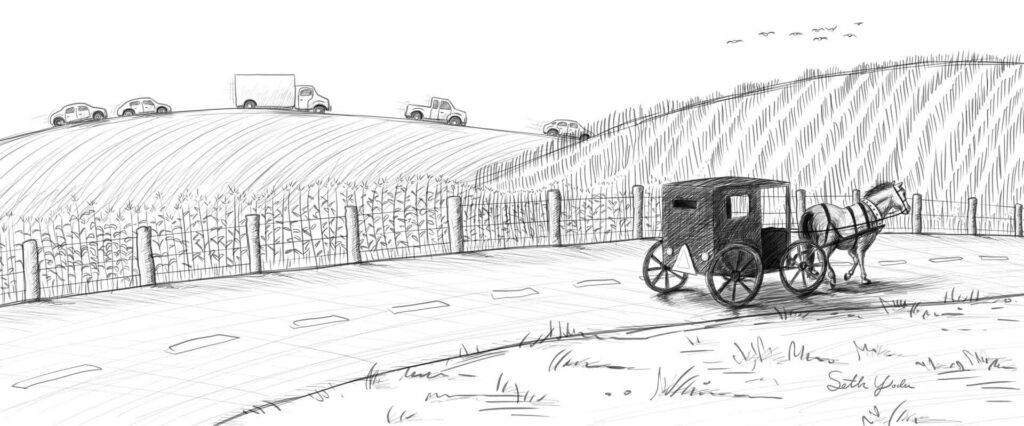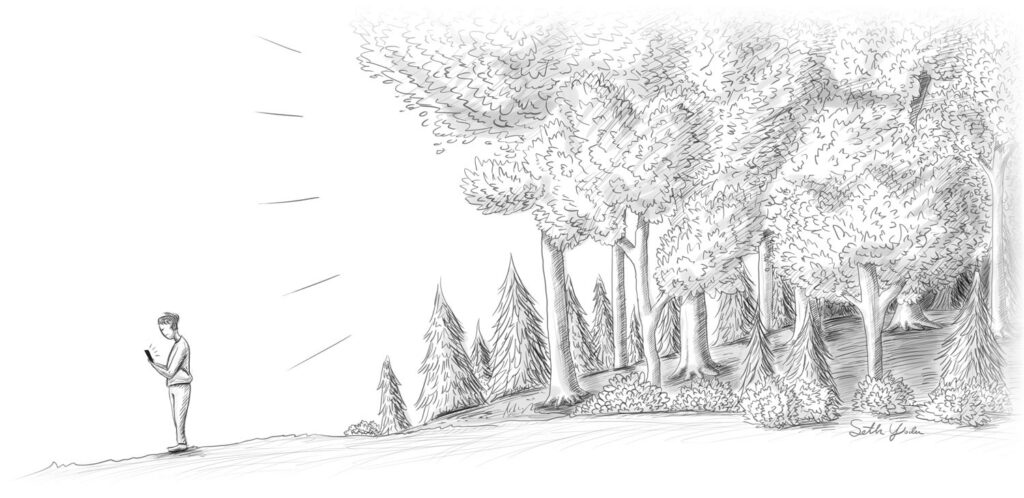by Ivan Keim, Plain Values
This Month’s Question:
The balance between the blessings and pit-falls of modern-day technology can be hard to find. How do we balance using technology with staying connected to our community?
Answered by: Ivan Keim, a minister in his local Amish church
“How do we balance using technology with staying connected to our community?” This is a more complex question than can be answered in a short column, but we will focus on a few key areas where technology is challenging us as a society. How do we view technology? What is technology? Webster’s Dictionary defines technology as “the totality of the means employed to provide objects necessary for human sustenance and comfort.” Imagine the mode of transportation since the beginning of time: humans and animals were designed to walk. If we wanted to move from one location to the next, we moved our legs and walked. Animals were hitched to sleds or other objects as they dragged them over the ground to move them, and then they added wheels to make it easier to pull. They could now carry more weight and pull it greater distances. This increased the comfort level for its users.
For thousands of years, man relied on animal power to pull their wagons with goods and people until the 1800s when the steam engine was attached to this wheel-driven technology that had been developed centuries prior. Technology has continued to improve our mode of transportation over the last 250 years. We can now travel across the globe in less than a day.

When Henry Ford started producing cars for the masses in the 1920s, our Amish forefathers were concerned that it would harm our family unit and be a hindrance to our communities. They chose to stay with horse and buggy transportation. This has kept us closer together and limits the ability to come and go with ease. As family members moved to other communities and employment started to move away from the farm, it also brought some challenges. Today we have a network of taxi drivers that provide transportation in times of need when horse and buggy does not suffice. We can still see the benefit of horse and buggy travel to keep us together as a community, but we have recognized the need for occasional motor vehicle transportation. In his book What the Amish Teach Us, Donald Kraybill states the following:
“Controlled access to motor vehicles keeps faith with tradition while giving just enough freedom to maneuver in the larger society. It allows the use of modern technology without being enslaved by it or allowing it to fray the social fabric.“
In this same way, we are being challenged with electronic technology, from the phone to the computer to the internet, which seems to connect everything in today’s world. Some churches have opted to say “no” to all means of electronic technology, while others have chosen to use some of it, but with limitations.
Electronic technology is challenging the way that we relate to each other. Deep, meaningful relationships fulfill our lives. When we have conversations with each other, we get to know what the other person is experiencing. If we stop long enough to truly listen and understand what our friend is saying, we can understand how he is feeling. More is said by our body language and tone of voice than the actual words that are said. Electronic communication has advanced so rapidly over the years that it has replaced a lot of our face-to-face communication. Electronic communication cannot replace the emotions and feelings that are shared when we look somebody in the eye and see their excitement or feel their pain.
This fall, our son shot his first deer during the youth gun season. When we came home, we could all partake in the joy as he relayed the experience to his mom and his sisters. There were cheers and excitement and they saw his beaming eyes, complete with all the emotions experienced at a time like this. If we had sent home a quick text message, “kenneth shot deer,” the value of sharing the moment and the electricity with sharing it firsthand would have died off by the time we got home.
As our society relies more and more on electronic communication, we lose the ability to have those meaningful relationships that pull us together. We are able to relay messages better and quicker, but is it bringing us closer together?

Ever since the beginning of time when God said, “It is not good that man should be alone,”1 man has longed to be in relationship with others. When Jesus walked on the Earth, he explained “thou shalt love the Lord thy God with all thy heart, and with all thy soul, and with all thy mind. This is the first and great commandment. And the second is like unto it, thou shalt love thy neighbor as thyself.”2 We have been designed with a desire to be part of something that is greater than us. We get a feeling of satisfaction and accomplishment when we belong to a group of people who are working towards a greater cause.
When we belong to something, we also have a responsibility that comes with accountability. Growing up, we all belonged to a family. Each family had their set of rules that we abided by, and if we did not conform, there were consequences.
In the digital world, we can now belong to a “community” that has no responsibilities or accountability. There are online platforms for pretty much any interest that you may have. If it comes to the point where we do not agree, we just drop out. There are no responsibilities, and I am not accountable to anybody. In the end, this “relationship” does not bring the joy and fulfillment that a one-on-one relationship brings. It also does not teach us the grit and hard work that a good relationship requires. We get so used to just “dropping out” if it does not go well that we struggle to learn the art of “getting along with other people.”
With general society completely immersed in electronic technology and the Plain communities trying to traverse the raging waters of this digital sea, we are all affected by it. So what can we do to tame the tiger—or at least cage it—so that it will not devour us all?
First, for the people who are used to having electronic communication at their fingertips all the waking hours of the day, there are a few questions to ponder.
- Are you willing to lay it aside and enjoy the people around you?
- Can you shut off all communication devices during meals and family time?
- Would it be possible to eliminate electronic communication outside of work hours?
May I go so far as to suggest removing the TV from the main room of the house? Or consider this: are you willing to remove it altogether?
Start by setting an evening aside each week to do something together as a family with no electronic interruptions. Play a board game. Do a work project together. Take a walk through the woods, and enjoy the natural beauty that God created.
In the last chapter of his book, Surviving the Tech Tsunami, Gary Miller shares this with us:
Our churches must be awake, aware, and actively addressing this issue. But we cannot stop there. Not everyone is blessed to be part of a fellowship that is seriously confronting this problem. Therefore, it is essential that we prepare personally for the coming onslaught. Regardless how often your congregation meets (and it should be often), or how much dialogue you have (and there should be plenty), or how much thought you give to collective agreements (and that should be much), ultimately it will be your personal connection with God that will empower you to survive and thrive in this tech tsunami.
If you would like to learn more on the subject of technology, Surviving the Tech Tsunami by Gary Miller is a good read.
FOOTNOTES:
1) Genesis 2:18
2) Matthew 22:37–39
This article was published in the January 2023 issue of Plain Values Magazine. If you want the latest Q&A’s every month (including two panelist answers), subscribe to the magazine at plainvalues.com. As a special thanks, get 10% off your subscription with the code “GAB23”!
Email us your own questions for The Roundtable at [email protected].

Ivan, Emma, and their four children live on a 12-acre homestead where they strive to raise as much of their own food as possible. Each year they have a large garden, harvest from their orchard, use raw milk from their own cow, and process chicken, turkey, beef, and pigs for their freezers. Ivan is a minister in the local Amish community. He builds tiny homes and animal shelters for a living. His models can be seen on www.tinyhomeliving.com





